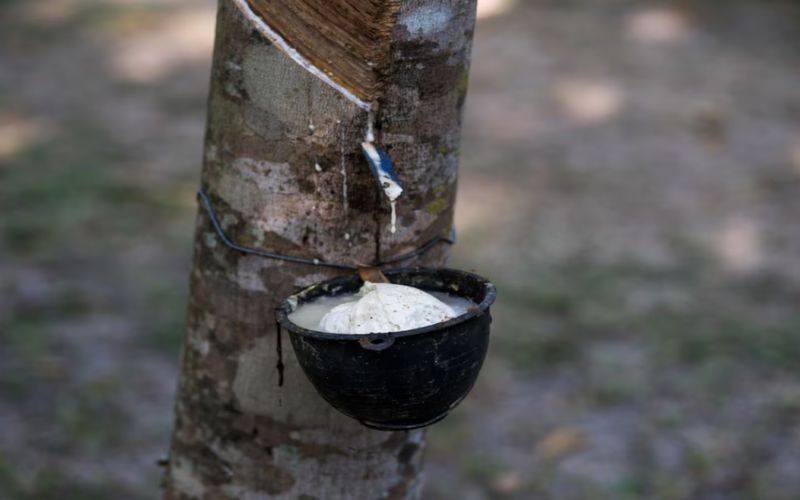Kerala is known for its thriving rubber industry, which plays a crucial role in the state’s economy. The region’s tropical climate and fertile soil make it an ideal location for rubber cultivation, and the industry has been a significant contributor to Kerala’s economic growth for decades. From small-scale farmers to large-scale plantations, the rubber industry in Kerala employs thousands of people and generates substantial revenue.
The rubber industry in Kerala is not only important for the state’s economy but also for the livelihoods of many families. The price of rubber is a crucial factor that determines the income and well-being of these individuals. Fluctuations in the price of rubber can have a significant impact on the financial stability of both farmers and the overall industry.
Factors influencing the price of rubber
The price of rubber in Kerala is influenced by a variety of factors, both local and global. Some of the key factors that can impact the price of rubber include:
- Supply and Demand: The balance between the supply of rubber and the demand for it can significantly affect the price. Factors such as weather conditions, crop yields, and global economic trends can influence the supply and demand dynamics.
- International Market Trends: Kerala’s rubber industry is closely tied to the global rubber market, and the prices in Kerala are often influenced by international market trends. Fluctuations in the prices of natural and synthetic rubber in the global market can have a direct impact on the prices in Kerala.
- Government Policies: Government policies, such as import/export regulations, taxation, and subsidies, can also play a role in shaping the rubber prices in Kerala.
- Transportation and Logistics: The cost of transporting rubber from the plantations to the processing facilities and eventual markets can also affect the final price.
- Production Costs: The cost of inputs, such as labor, fertilizers, and equipment, can influence the overall production costs and, consequently, the rubber prices.
Understanding the concept of 1 kg rubber price
The term “1 kg rubber price” refers to the market price of one kilogram of natural rubber in Kerala. This price is typically quoted in Indian Rupees (INR) and is a crucial indicator for both rubber farmers and buyers.
The 1 kg rubber price is influenced by various factors, as mentioned earlier, and can fluctuate on a daily or weekly basis. Understanding the current 1 kg rubber price is essential for farmers to make informed decisions about their crop management and sales, as well as for buyers to plan their procurement strategies.
Historical trends of rubber prices in Kerala
The rubber prices in Kerala have experienced significant fluctuations over the years, reflecting the dynamic nature of the industry. Here’s a brief overview of the historical trends:
- 2010-2015: During this period, the 1 kg rubber price in Kerala ranged from around ₹150 to ₹220, with occasional spikes and dips.
- 2016-2020: The rubber prices in Kerala saw a downward trend, with the 1 kg price dropping from around ₹160 in 2016 to around ₹130 in 2020.
- 2021: The year 2021 has been a mixed bag for rubber prices in Kerala. The prices started the year on a positive note, with the 1 kg price reaching around ₹170 in the first quarter. However, the market has since experienced some volatility, with the current 1 kg rubber price in Kerala ranging from ₹150 to ₹170.
These historical trends highlight the dynamic nature of the rubber industry and the importance of staying informed about the latest market conditions to make informed decisions.
Current market situation and the impact of 2021 on rubber prices
The rubber industry in Kerala has faced several challenges in 2021, which have had a significant impact on the 1 kg rubber price. Some of the key factors that have influenced the market situation include:
- COVID-19 Pandemic: The ongoing COVID-19 pandemic has disrupted supply chains and affected the demand for rubber, leading to price fluctuations.
- Weather Conditions: Erratic weather patterns, such as heavy rainfall and droughts, have impacted rubber production in Kerala, affecting the overall supply and, consequently, the prices.
- Global Economic Trends: The global economic situation, including factors like trade tensions and fluctuations in the prices of other commodities, has also influenced the rubber prices in Kerala.
- Government Policies: Changes in government policies, such as import/export regulations and taxation, have had a direct impact on the rubber prices in the state.
As a result of these factors, the 1 kg rubber price in Kerala has experienced significant volatility in 2021, ranging from around ₹150 to ₹170. Understanding the current market situation and the factors driving these price changes is crucial for both rubber farmers and buyers to make informed decisions.
Factors to consider before investing in rubber
Investing in the rubber industry in Kerala can be a lucrative opportunity, but it also comes with its own set of risks and considerations. Before making any investment decisions, it’s essential to carefully evaluate the following factors:
- Market Trends: Closely monitor the historical and current trends in rubber prices to understand the market dynamics and potential risks.
- Production Costs: Assess the production costs, including labor, inputs, and transportation, to ensure the investment remains profitable.
- Government Policies: Stay informed about any changes in government policies that may impact the rubber industry, such as taxation, subsidies, or import/export regulations.
- Environmental Factors: Consider the impact of weather conditions and climate change on rubber production, as these can significantly affect the supply and, consequently, the prices.
- Competition: Analyze the competitive landscape, including the presence of other players in the market and their strategies, to identify potential challenges and opportunities.
- Financial Considerations: Evaluate the financial viability of the investment, including the initial capital requirements, expected returns, and potential risks.
By carefully considering these factors, you can make informed decisions and minimize the risks associated with investing in the rubber industry in Kerala.
How to stay updated with the latest rubber prices in Kerala
Staying informed about the latest rubber prices in Kerala is crucial for both farmers and buyers. Here are some effective ways to stay updated:
- Online Price Tracking Platforms: Several online platforms, such as commodity exchanges and government websites, provide real-time updates on rubber prices in Kerala. These platforms can be accessed through your computer or mobile device.
- Local Market Monitoring: Regularly visit local rubber markets and interact with traders and farmers to stay informed about the current market conditions and price trends.
- Industry Publications: Subscribe to industry-specific publications, magazines, or newsletters that provide regular updates and analyses on the rubber industry in Kerala.
- Government Agencies: Stay connected with government agencies, such as the Rubber Board of India, which provide comprehensive information on rubber prices, production, and market trends.
- Social Media: Follow relevant industry groups, experts, and organizations on social media platforms like LinkedIn, Twitter, or Facebook to stay updated on the latest developments in the rubber industry.
By utilizing these resources, you can stay informed about the 1 kg rubber price in Kerala and make well-informed decisions for your business or investment.
The role of government policies in the rubber industry
The government plays a crucial role in shaping the rubber industry in Kerala. Through various policies and initiatives, the government can influence the production, trade, and pricing of rubber in the state. Some of the key government interventions include:
- Regulatory Policies: The government sets policies related to import and export regulations, taxation, and subsidies, which can impact the overall market dynamics and rubber prices.
- Research and Development: The government supports research and development initiatives to improve rubber production techniques, crop yields, and processing methods, which can enhance the industry’s efficiency and competitiveness.
- Infrastructure Development: Investments in transportation, storage, and processing infrastructure can help reduce the overall costs and improve the supply chain efficiency, ultimately affecting the rubber prices.
- Farmer Support Programs: The government offers various support programs, such as subsidies, crop insurance, and extension services, to assist rubber farmers and ensure their financial stability.
- Market Interventions: In times of extreme price volatility, the government may intervene in the market to stabilize prices and protect the interests of both farmers and consumers.
By understanding the role of government policies in the rubber industry, stakeholders can better anticipate and adapt to the changing market conditions, making more informed decisions about their businesses or investments.
Tips for buying and selling rubber in Kerala
Whether you are a rubber farmer, a trader, or a buyer, navigating the rubber market in Kerala requires a certain level of expertise. Here are some tips to help you buy and sell rubber effectively:
- Stay Informed: Continuously monitor the latest rubber prices, market trends, and industry developments to make informed decisions.
- Establish Reliable Connections: Build strong relationships with farmers, traders, and industry experts to access reliable information and secure favorable deals.
- Timing is Key: Understand the seasonal fluctuations in rubber production and prices, and time your buying and selling activities accordingly.
- Diversify Your Portfolio: Consider diversifying your investments or sourcing across different rubber-producing regions to mitigate risks and capitalize on market opportunities.
- Leverage Technology: Utilize digital platforms, mobile apps, and online marketplaces to streamline your buying and selling processes and stay connected with the latest market updates.
- Understand Grading and Quality Standards: Familiarize yourself with the different rubber grades and quality standards to ensure fair pricing and transactions.
- Negotiate Wisely: Develop effective negotiation skills to secure the best possible prices for your rubber, whether you are buying or selling.
- Comply with Regulations: Stay informed about the relevant laws, regulations, and documentation requirements to ensure the legality and smooth execution of your transactions.
By following these tips, you can navigate the rubber market in Kerala with confidence and make well-informed decisions that align with your business objectives.
Conclusion
The rubber industry in Kerala is a crucial component of the state’s economy, and the 1 kg rubber price is a crucial indicator for both farmers and buyers. The market has experienced significant fluctuations in recent years, driven by a combination of local and global factors.
As we look to the future, the rubber industry in Kerala is likely to face both challenges and opportunities. The ongoing COVID-19 pandemic, climate change, and global economic trends will continue to shape the market dynamics, and stakeholders must be prepared to adapt to these changes.
However, the inherent strengths of the Kerala rubber industry, such as its favorable climate, skilled workforce, and government support, provide a solid foundation for growth and resilience. With strategic investments, technological advancements, and effective policy interventions, the rubber industry in Kerala can continue to thrive and contribute to the state’s economic development.
By staying informed about the latest market trends, understanding the factors that influence rubber prices, and making well-informed decisions, both farmers and buyers can navigate the rubber industry in Kerala and capitalize on the opportunities that arise.
To stay up-to-date with the latest 1 kg rubber price in Kerala and other industry insights, subscribe to our newsletter. Our team of experts will provide you with regular updates and analysis to help you make informed decisions for your business or investment. Sign up now and take the first step towards success in the Kerala rubber industry.



